
The Bentley Arnage is a full-size luxury car manufactured by Bentley Motors in Crewe, England, from 1998 to 2010. The Arnage and its Rolls-Royce-branded sibling, the Silver Seraph, were introduced in the spring of 1998. They were the first entirely new designs for the two marques since 1980.
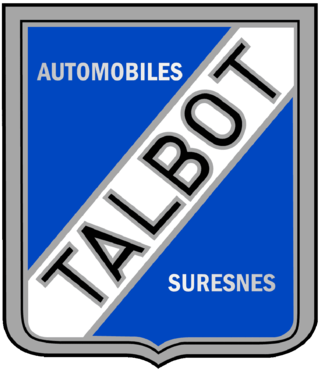
Talbot-Lago was a French automobile manufacturer based in Suresnes, Hauts de Seine, outside Paris. The company was owned and managed by Antonio Lago, an Italian engineer that acquired rights to the Talbot brand name after the demise of Darracq London's subsidiary Automobiles Talbot France in 1936.

The Arab was a high-performance English automobile designed by Reid Railton and manufactured in Letchworth, Hertfordshire, between 1926 and 1928. The factory had previously been used by the Phoenix car company.
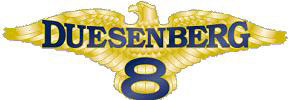
Duesenberg Automobile & Motors Company, Inc. was an American racing and luxury automobile manufacturer founded in Indianapolis, Indiana, by brothers Fred and August Duesenberg in 1920. The company is known for popularizing the straight-eight engine and four-wheel hydraulic brakes. A Duesenberg car was the first American car to win a Grand Prix race, winning the 1921 French Grand Prix. Duesenbergs won the Indianapolis 500 in 1922, 1924, 1925 and 1927. Transportation executive Errett Lobban Cord acquired the Duesenberg corporation in 1926. The company was sold and dissolved in 1937.

In automotive engineering a multi-valve or multivalve engine is one where each cylinder has more than two valves. A multi-valve engine has better breathing and may be able to operate at higher revolutions per minute (RPM) than a two-valve engine, delivering more power.

The Bugatti Type 35 is an iconic race car design produced by Bugatti at their Molsheim premises between 1924 and 1930. It was extremely successful when raced by the factory works team. It was also bought by a diverse roster of privateer clientele from around the world. It pioneered the concept of a holistically conceived, race-ready car available for purchase.
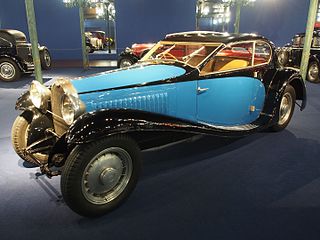
The Bugatti Type 46 and later Type 50 were large enclosed touring cars and along with the Type 50B racing version, were all produced in the 1930s. Their relative ubiquity and numbers, combined with their styling caused them to sometimes receive the appellation of being a Molsheim Buick.

Sir Henry Ralph Stanley Birkin, 3rd Baronet, known as Tim Birkin, was a British racing driver, one of the "Bentley Boys" of the 1920s.

The Bentley 4½ Litre is a British car based on a rolling chassis built by Bentley Motors. Walter Owen Bentley replaced the Bentley 3 Litre with a more powerful car by increasing its engine displacement to 4.4 litres. A racing variant was known as the Blower Bentley.

The Bentley 6½ Litre and the high-performance Bentley Speed Six were rolling chassis in production from 1926 to 1930. The Speed Six, introduced in 1928, became the most successful racing Bentley. Two Bentley Speed Sixes became known as the Blue Train Bentleys after their owner Woolf Barnato raced the Blue Train in 1930.

The Bentley 3½ Litre was presented to the public in September 1933, shortly after the death of Henry Royce, and was the first new Bentley model following Rolls-Royce's acquisition of the Bentley brand in 1931.

The Bentley 8 Litre was a large inline 6-cylinder super-luxury car made in various configurations by Bentley Motors Limited at Cricklewood, London. Announced 15 September 1930, it was also the last completely new model by Bentley before the company's financial collapse and forced sale to Rolls-Royce Limited.
The 1930 24 Hours of Le Mans was the 8th Grand Prix of Endurance that took place at the Circuit de la Sarthe on 21 and 22 June 1930. It saw the first appearance of a German car and the first entry from female drivers.
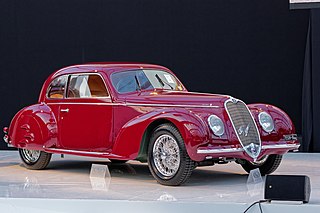
The Alfa Romeo 6C name was used on road, race, and sports cars produced between 1927 and 1954 by Alfa Romeo; the "6C" name refers to the six cylinders of the car's straight-six engine. Bodies for these cars were made by coachbuilders such as James Young, Zagato, Touring Superleggera, Castagna, and Pinin Farina. Beginning in 1933 there was also a 6C version with an Alfa factory body, built in Portello. In the early 1920s Vittorio Jano received a commission to create a lightweight, high performance vehicle to replace the Giuseppe Merosi designed RL and RM models. The car was introduced in April 1925 at the Salone dell' Automobile di Milano as the 6C 1500. It was based on Alfa's P2 Grand Prix car, using a single overhead cam 1,487 cc in-line six-cylinder engine, producing 44 horsepower. In 1928 the 1500 Sport was presented, which was the first Alfa Romeo road car with double overhead camshafts.

The Lancia Artena is a passenger car produced by Italian car manufacturer Lancia from 1931 until 1936, and from 1940 until 1942 chiefly for army and government use. It was powered by a 2-litre Lancia V4 engine, while chassis and factory bodies were shared with the more luxurious 2.6-litre V8-engined Lancia Astura. Total production amounted to 5,567 examples.

Bentley Blower No.1 is a racing car developed from the Bentley 4½ Litre by Sir Henry "Tim" Birkin to win the Le Mans twenty-four-hour race. The car was developed into its current form for racing at Brooklands.
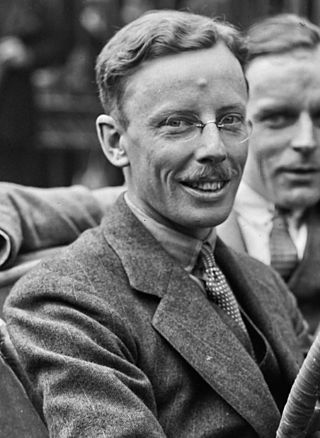
Colonel Reginald Clive Gallop was an engineer, racing driver and First World War pilot. He was one of the team which developed their first engine for Bentley Motors.
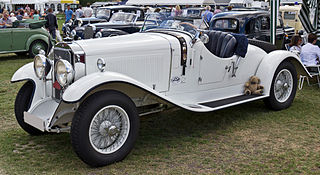
The Mercedes-Benz W08 was a large luxury car produced by Daimler-Benz. It was introduced in Autumn 1928, as Mercedes-Benz's first eight-cylinder passenger car. Also known by various “type numbers”, it remained in production with various modifications and upgrades until the later summer of 1939, the longest lived Mercedes-Benz model of the 1920s and 1930s.

The Lagonda 14/60 was a sports touring car introduced by Lagonda in 1925. Production of the 14/60 continued until 1931. As well as the standard car there were variants called the 2 Litre Speed (1927–33) and Continental.


























